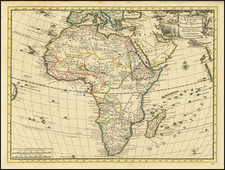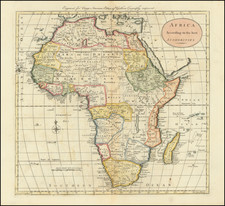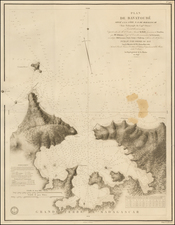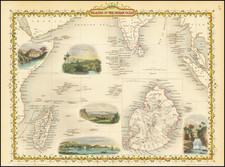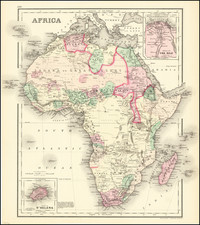Views of the Senegal Coast From the Churchills’ Celebrated Voyage Collection
A fine set of views showing Rufisco, today Rufisque, in Senegal, as well as Cape Verde and Gorée. They featured in the voyage account of Jean Barbot in the Churchill brothers’ renowned voyage collection, published in London in 1732.
The maps of the Guinea and Gold Coasts in this collection, engraved by Johannes Kip, offer some of the most detailed views of the trading settlements and slave forts ever published.
Taking up the top two-thirds of the page is a view of Rufisco, today the city of Rufisque in Senegal. The view shows an idyllic bay with several sailing vessels and canoes. An indigenous village is arrayed near the shore, while the legend indicates the mayor/alcalde’s house and the French lodge.
Rufisque was initially a fishing village called Tëngéej. In the sixteenth century, it became the principal port of the Cayor Kingdom, where they traded with the Portuguese and later the French, Dutch, and English. The Portuguese called the town “Rio Fresco,” or Fresh River, which is the source of its present name of Rufisque. In time, a Métis community of Euro-African creoles came to live in the town.
Below, three views of Cape Verde are included. In the bottom right corner is a “prospect” of Cape Emmanuel and the island of Gorée. Gorée, near Dakar, Senegal, was not inhabited prior to the arrival of Europeans because it has very little fresh water. The Portuguese built a chapel and cemetery on the island in the mid-fifteenth century and later it was used as a settlement, many of whose inhabitants were involved in the slave trade. Today the island houses a museum dedicated to the history of the slave trade, as there were holding centers for enslaved people prior to their forced migration to the Americas.
Jean Barbot
This view derived from the descriptions provided by Jean Barbot (1655-1712), a Frenchman. The French had begun to contest Portuguese trading on the Gold Coast in the 1530s; Barbot worked for the Compagnie du Sénégal. He went to Africa twice between 1678 and 1682, when he visited many of the forts along the coast.
A Huguenot, Barbot had to flee France after the 1685 Edict of Nantes, settling in England. He had finished a draft of his voyage account by 1688, but failed to find a publisher for the work. Instead, it only appeared in print in 1732, as part of the Churchill’s expanded voyage collection.
Barbot has long been used as a primary source of information about the Gold Coast. In recent decades, however, his account has been called into question by scholars. Comparisons of his work with other contemporary sources reveal that he relied on other African travelers as well, especially the Dutchman Olfert Dapper.
The Churchills’ voyage collection
The Churchill brothers, Awnsham (1658-1728) and John (ca. 1663-ca. 1714), were publishers in London who catered to an affluent clientele, and they were from a prominent family themselves. A distant relative was John Churchill, the Duke of Marlborough. Two of their older brothers, Joshua and William, served as Members of Parliament. Awnsham also was elected an MP for Dorcester in the first years of the eighteenth century.
In 1704, they released the first edition of one of their most successful works, A collection of voyages and travels: some now first printed from original manuscripts, others now first published in English. The collection consisted of four volumes of voyages and travel accounts derived from primary sources in English, French, Dutch, Italian, Spanish, and German, a feat not seen since Hakluyt’s work over a century earlier.
The Churchill brothers are perhaps best-known today as the publisher of the works of John Locke. Awnsham supported religious tolerance and moderation for nonconformists, stances that would have appealed to Locke. Locke is supposed to have written the introductory discourse which opens the voyage collection.
These views appeared in the 1732 expanded edition, which extended the collection to six volumes. Barbot’s Description of the Coasts of North and South Guinea featured in the fifth volume. A further edition of eight volumes was issued in 1752.
The collection was widely respected and considered one of the most prestigious examples of the genre in the eighteenth century. The maps and illustrations from the collection are relatively scarce on the market, especially given how important the publication was when it debuted.
Johannes Kip (1653-1722) was a topographical engraver. Born in the Netherlands, he had immigrated to England by 1690. His most famous work are the engravings of country houses in Britannia Illustrata (1707), which he produced with Leonard Knyff. He also contributed to the 1732 expanded edition of the Churchill brothers voyage collection.










